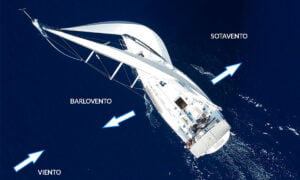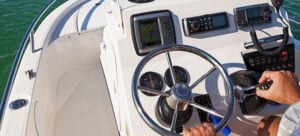When browsing it is extremely important to collect information about the weather. This directly affects the state of the water, which in turn acts on the boat, with the consequent decrease in its safety and that of the crew.
Therefore, it is extremely important to identify and understand concepts as relevant in meteorology as storms and anticyclones. If you want to delve deeper into these atmospheric phenomena, just keep reading.
What are storms?
Also called areas of low pressure or depressions, storms are those extensions formed by lines of closed isobars whose pressure is less than 1012 millibars or Hectopascals (hPa). The formation of a storm brings strong winds and abundant rainfall as a consequence. The main characteristics of storms are:
- Counterclockwise wind circulation (cyclonic circulation) in the Northern Hemisphere.
- Large pressure gradient, so isobars are close together.
- Little extension.
- Decrease in pressure from the periphery towards the interior.
- Accompanied by strong winds and precipitation and cloudiness.
- They are almost always mobile and move from W to E (at a speed of about 25 knots).
- On Spanish maps they are represented with a B, in the US and English with an L (LOW), in France with a D (depression) and in Germany with a T (TIEF).
How are storms formed?
They are formed when The air, when heated, becomes lighter and rises. When does this happen? It occurs when a cold front crosses a warm front. At that moment, the air mass heats up, rotates and ends up getting trapped inside it. That air that is trapped is called a storm. Its effects can be noticed between 4 and 7 days in the form of wind and rain.

What are anticyclones?
Anticyclones are also called high pressure areas. They are those extensions formed by lines of closed isobars whose pressure is greater than 1012 millibars or Hectopascals (hPa). The formation of an anticyclone produces good weather, clear skies, and occasionally fog or mist. Among its characteristics we can highlight:
- Clockwise wind circulation (anticyclonic circulation) in the Northern Hemisphere.
- Small pressure gradient, so isobars are separated.
- Great extension.
- Increased pressure from the periphery towards the interior.
- Predominance of good weather with light or moderate winds.
- They are represented on weather charts with an A (Spain, Italy and France), with an H (HIGH, in the US and England; and HOCH in the German ones).
How are anticyclones formed?
An anticyclone occurs when there is a large-scale wind circulation around a central point of high atmospheric pressure. When an anticyclone occurs, the air descends from the upper layers of the atmosphere towards the ground, generating what is known as subsidence.
Are you interested in: Stability of a ship
How does the wind circulate in storms and anticyclones?
The first thing is to know what the wind is. Wind is defined as moving air masses. The sun heats the Earth unevenly, with the atmosphere receiving most of this heat.
Air, like any gas, expands when heated, so its volume is greater (Weight = Volume x Density) and, consequently, its density decreases and it tends to settle on the layers of higher density.
Higher density corresponds to higher pressure and lower density corresponds to lower pressure, therefore the air circulates from the high pressure cores to the low pressure cores. Wind circulation occurs when air masses move from high pressure cores to low pressure cores.
It does not follow a direct path due to a series of elements, among which we can highlight the movement of the Earth (geostrophic force), the centrifugal force of the circular movements of the air and the friction with the surface of the earth.
The combination of these forces causes the resulting force, the winds, to circulate practically parallel to the isobars.
The direction of the wind is indicated by the place where it comes from (32 points or quarters of the compass rose, or in circular degrees from 0º to 360º).
How the wind circulates in storms
In the case of storms, the winds circulate in a cyclonic direction, which is counterclockwise in the Northern Hemisphere from the outside to the inside, looking for the lowest pressure nuclei.
Within the North Atlantic and, as a general rule, storms move from west to east (WE).
Many of those that affect the European continent are born on the coasts of the United States and Canada, although most of them die before reaching the European coasts. There are branches that head to the NE and end in Iceland, others, that of the polar fronts when they descend in latitude, reach the English Channel and extend to Norway and Finland.
The trajectory in the Iberian Peninsula is usually ENE although it depends a lot on the nearby anticyclones, which usually force it to change direction.
How the wind circulates in anticyclones
The air circulates in an anticyclonic direction, clockwise in the Northern Hemisphere and divergent in nature, that is, from the inside out looking for the nuclei with the lowest pressure.
Has this article helped you? If you want to know more about all the aspects that influence navigation, you can continue reading some of our posts. If what interests you most are the courses and internships to obtain the PER degree, you just have to visit our website and consult our offer.





